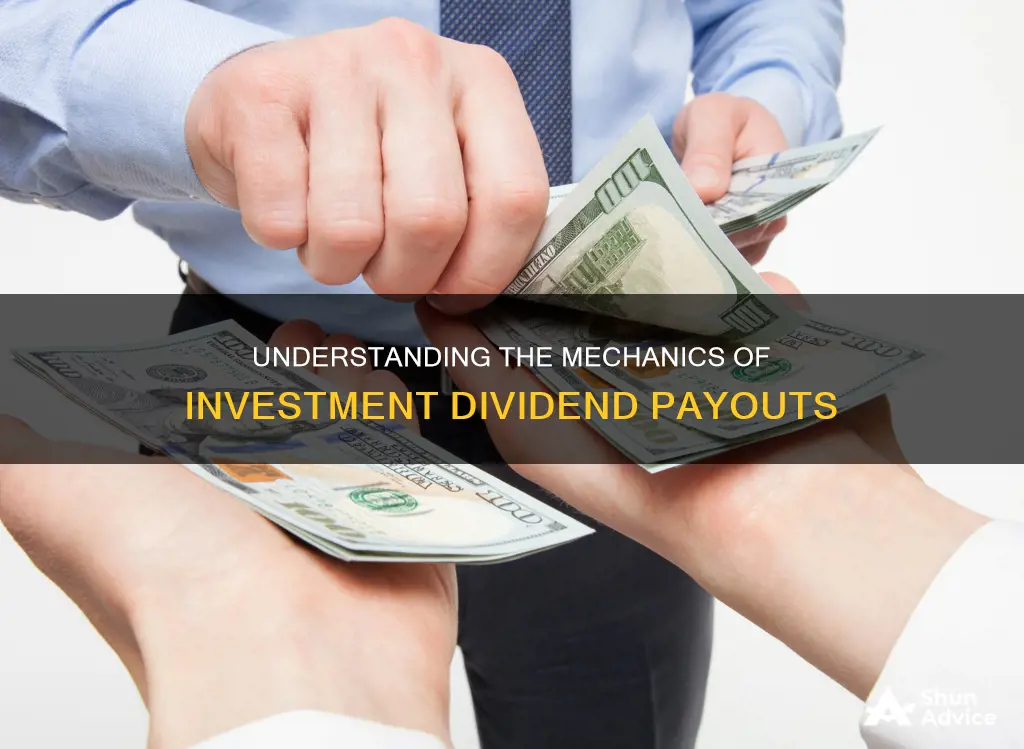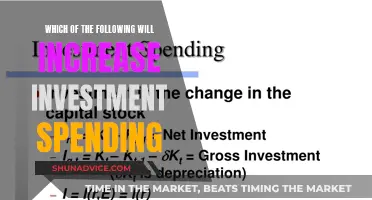
Dividends are a way for companies to distribute profits to their shareholders. Companies can either reinvest their earnings or share them with investors. Dividends are usually paid out quarterly, but they can also be paid out on a monthly, semi-annual, or annual basis. Dividend payments and amounts are determined by the company's board of directors.
Dividends can be paid in cash or additional shares. Cash dividends are the most common form of dividend payment, but some companies may offer stock dividends, which are a percentage increase in the number of shares owned. Dividend reinvestment plans (DRIPs) allow investors to automatically reinvest their cash dividends into additional shares.
To receive a dividend, an investor must be a shareholder of record on the record date. The record date is the date that determines which shareholders are entitled to receive the dividend payment. The ex-dividend date is the date before which an investor must purchase the stock to receive the upcoming dividend. The declaration date is when the company announces the dividend amount and sets the ex-dividend date, record date, and payment date. The payment date is when the company deposits the funds for disbursement to shareholders.
| Characteristics | Values |
|---|---|
| How dividends are paid | Cash dividends are paid as a cash payment or check, or as additional shares of stock. |
| When dividends are paid | Dividends are usually paid quarterly, but can also be paid monthly, semi-annually or annually. |
| Who decides on dividend payments | The company's board of directors decides on dividend payments and amounts. |
| Who receives dividend payments | Shareholders of record are eligible to receive dividend payments. |
| When shareholders must buy shares by to receive a dividend | Shareholders must buy shares before the ex-dividend date to receive the next dividend payment. |
| How much shareholders receive | The amount received depends on the number of shares owned. |
| Dividend yield | The dividend yield is the annual dividend per share divided by the share price, expressed as a percentage. |
| Dividend payout ratio | The dividend payout ratio is the annual dividends per share divided by the earnings per share. |
| Dividend growth rate | The dividend growth rate is the annualised percentage increase in a company's dividend per share. |
| Dividend coverage ratio | The dividend coverage ratio is the company's operating cash flow divided by the total dividends paid. |
| Earnings yield | The earnings yield is the earnings per share divided by the share price. |
| Price-to-dividend ratio | The price-to-dividend ratio is the company's current stock price divided by its annual dividend payout. |
| Debt-to-equity ratio | The debt-to-equity ratio is the company's total debt divided by its total assets. |
What You'll Learn

Dividend declaration and payment dates
Declaration Date
The declaration date is when the dividend is officially announced by the company's board of directors. On this date, the dividend amount, ex-dividend date, record date, and payment date are set. This is the date that the company commits to distributing profits to its shareholders.
Ex-Dividend Date
The ex-dividend date, or ex-date, is crucial for investors as it determines their eligibility to receive the upcoming dividend. If an investor purchases the stock on or after the ex-dividend date, they will not be entitled to the upcoming dividend payment. The ex-dividend date is usually set one business day before the record date.
Record Date
The record date is the cutoff date used by the company to determine which shareholders are eligible to receive the declared dividend. An investor must be listed as a shareholder on the company's books on this date to receive the dividend. The record date typically occurs two business days after the ex-dividend date.
Payment Date
The payment date is the day when the company distributes the declared dividend to its qualified shareholders. This date usually falls about one month after the record date. The dividend payment is deposited into the shareholders' brokerage accounts or sent via dividend checks.
Why Early College Programs Are Worth the Investment
You may want to see also

Dividend reinvestment plans
DRIPs are offered by individual companies and mutual funds. They are usually commission-free and allow investors to buy shares at a discount. DRIPs are beneficial for investors as they allow them to compound their returns over time by accumulating more shares, which pay dividends that will be reinvested.
There are two main types of DRIPs: brokerage account plans and company DRIPs. Brokerage account plans allow investors to access multiple investment types, such as individual stocks, mutual funds, and ETFs, all from one account. Company DRIPs, on the other hand, are solely for investors who want to invest in individual stocks and are more limiting in terms of investment options.
While DRIPs offer many advantages, there are also some downsides. One of the main disadvantages is that investors don't receive the cash from the dividend, which could be used for other purposes. Additionally, taxes must be paid on reinvested dividends, which can be a burden for some.
Overall, DRIPs can be a powerful tool for investors to boost their returns over the long term, but it is important to carefully consider the pros and cons before enrolling in any plan.
John Cabot's First Expedition: Investors' Motives
You may want to see also

Dividend taxation
Dividends are always considered taxable income by the IRS, regardless of the form in which they are paid. The specific tax implications vary depending on the type of dividend declared, the account type in which the shareholder owns the shares, and how long the shareholder has owned the shares.
Qualified Dividends
Qualified dividends are ordinary dividends that meet the criteria to be taxed at capital gains tax rates, which are lower than income tax rates for some taxpayers. The maximum tax rate for qualified dividends is 20%, with a few exceptions for real estate, art, or small business stock.
To be considered a qualified dividend, the shareholder must have held the stock for more than 60 days in the 121-day period that began 60 days before the ex-dividend date. The ex-dividend date is one market day before the dividend's record date, which is the date a shareholder must be on the company's books to receive the dividend.
For the 2023 tax year, the tax rates for qualified dividends are as follows:
- 0% if taxable income is less than $44,625 for singles and $89,250 for married couples filing jointly
- 15% if taxable income is between $44,626 and $492,300 for singles or between $89,251 and $553,850 for married couples filing jointly
- 20% if taxable income exceeds $492,300 for singles or $553,850 for married couples filing jointly
For the 2024 tax year, the tax rates for qualified dividends are as follows:
- 0% if taxable income is less than $47,025 for singles and $94,050 for married couples filing jointly
- 15% if taxable income is between $47,026 and $551,350 for singles or between $94,051 and $583,750 for married couples filing jointly
- 20% if taxable income exceeds $551,350 for singles or $583,750 for married couples filing jointly
Ordinary Dividends
Ordinary dividends are taxed at income tax rates, which, for the 2023 tax year, max out at 37%. For the 2024 tax year, the tax rates for ordinary dividends are the same as the standard income tax brackets.
Non-Qualified Dividends
Certain dividend payments are not qualified dividends even if they are reported as such. These include capital gains distributions and dividends received from a farmers' cooperative.
Fear of Losing Money: Why People Don't Invest
You may want to see also

Dividend yield and payout ratios
Dividend Yield
Dividend yield tells investors the simple rate of return they are getting in the form of cash dividends. It is calculated by dividing the dividend amount per share by the share price of the company's stock and is expressed as a percentage. For example, a company that paid out $10 in annual dividends per share on a stock trading at $100 per share has a dividend yield of 10%. Dividend yield can be misleading on its own, as some companies pay out dividends even when operating at a loss or without reinvesting enough capital into their business to maintain profitability.
Dividend Payout Ratio
The dividend payout ratio, on the other hand, represents how much of a company's net earnings are paid out as dividends. It is calculated by dividing the total amount of dividends paid by the company's net income. This ratio indicates how much money a company returns to shareholders versus how much it retains for debt repayment, reinvestment, or addition to cash reserves. A payout ratio of over 100% indicates that a company paid out more in dividends than it earned, which may not be sustainable in the long term.
Comparison
While dividend yield is more commonly known and scrutinized, many believe that the dividend payout ratio is a better indicator of a company's ability to distribute dividends consistently in the future. The dividend payout ratio is highly connected to a company's cash flow and can provide insights into its ability to maintain high dividend payments. Therefore, current shareholders and potential investors should evaluate both the dividend yield and the payout ratio when analysing a company's financial health and making investment decisions.
Fisher Investments: Happy Customers?
You may want to see also

Dividend growth and sustainability
Earnings and Cash Flow:
A company must have stable and growing earnings to support its dividend payouts. Investors should analyse a company's earnings growth rate and its ability to generate consistent profits over time. Additionally, a company's free cash flow, which is the cash generated after accounting for capital expenditures, is crucial. A company with strong free cash flow can maintain and increase its dividend payout, as it has excess cash to distribute.
Dividend Payout Ratio:
The dividend payout ratio is the percentage of earnings paid out as dividends. A high payout ratio may indicate that a company is paying out more than it can afford, while a low ratio may suggest that the company is retaining earnings for future growth. Investors should compare a company's payout ratio to its peers to determine sustainability.
Company Financial Health:
The financial health of a company is vital for dividend sustainability. Investors should consider the company's ability to meet its financial obligations, including debt payments, interest, and dividends. A stable and predictable cash flow is a key indicator of a company's ability to sustain dividend payments. Additionally, investors should examine the company's debt levels, interest coverage ratio, and free cash flow to assess its financial health.
Industry and Economic Factors:
Industry and economic trends can impact a company's ability to sustain dividend growth. Certain industries may be more susceptible to economic downturns, making it challenging to maintain consistent dividends. Economic conditions, such as recessions or periods of growth, can also affect a company's ability to pay dividends.
Management Decisions:
Management decisions play a significant role in dividend sustainability. Prioritising short-term gains over long-term stability can be concerning for investors, as it may lead to excessive debt and vulnerability to economic downturns. On the other hand, decisions that prioritise long-term stability, such as investing in research and development, can enhance dividend sustainability by increasing revenue and profits, creating a source of cash flow for dividend payments.
Finding the Balance:
When investing in dividend stocks, it's crucial to find the right balance between dividend yield and dividend sustainability. A high dividend yield may not always be sustainable, while a company with a lower yield but a strong track record of dividend sustainability can be a more attractive investment option. Earnings growth, payout ratio, cash flow, and industry trends are key factors to consider when evaluating dividend sustainability.
Investing: Separating Fact from Fiction
You may want to see also
Frequently asked questions
Dividends are a company's profits shared with shareholders, usually as cash but sometimes as additional shares. They are regular payments and not guaranteed.
Dividends are usually paid quarterly, but they can also be paid monthly, semi-annually or annually.
To be eligible for a dividend, you must be a shareholder of record on the record date. This is the date the company reviews its list of shareholders to determine who is eligible for the upcoming dividend.
The amount you are paid depends on the number of shares you own and the company's dividend policy. You can calculate the dividend yield by dividing the annual dividends per share by the share price.







